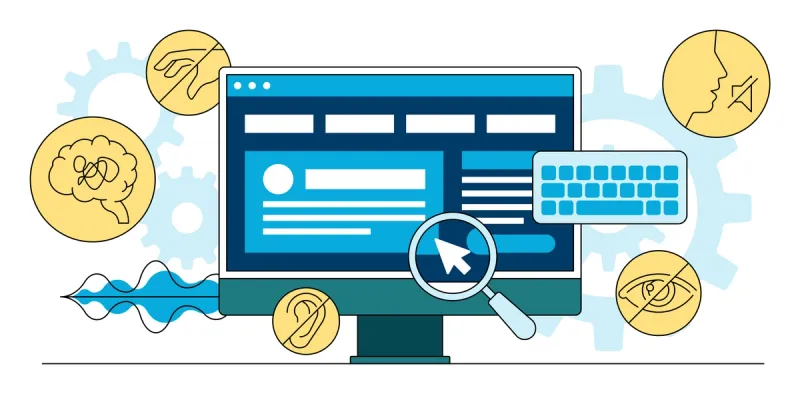Apryse Extends Support for PDF/UA Document Generation
By | 2023 Nov 27

4 min
Tags
pdf/ua
PDF accessibility
document generation
fluent
Summary
Apryse prioritizes digital inclusivity for the over 1 billion people with disabilities through PDF/UA compliance. Our solutions align with PDF/UA standards, enhancing accessibility for 15% of the global population dependent on assistive technology. The blog explains PDF/UA's significance, current standards, and looks ahead to the impending PDF/UA-2 release. Apryse offers Fluent and iText SDKs, facilitating accessible document creation, and we anticipate supporting PDF/UA-2 and express our commitment to universal accessibility.
Introduction
In a world where over a billion individuals live with some form of disability, the digital inclusivity provided by PDF/UA (Universal Accessibility) compliance is not just a courtesy—it's content generation table stakes. With this in mind, Apryse has dedicated recent development efforts to supporting this best practice by offering two innovative solutions aligned with the latest PDF/UA standards - crucial for 15% of the global population who require assistive technology to engage with digital content.
In this blog, we'll delve into the PDF/UA standard, its significance for creating inclusive digital content, and how these solutions empower developers and organizations to create reports and other documents that are truly accessible to all users.
Why is PDF/UA Necessary?
Like the PDF/A (Archiving) standard for long-term document preservation, the PDF/UA standard expands upon the general PDF 1.7 specifications with some additional requirements that PDF applications and assistive technologies (AT) can take full advantage of. However, making PDF documents more accessible can benefit everyone - not just those affected by disabilities. Improving general accessibility of PDF documents for disabled persons by adding more structure, meta-data and ensuring text content is stored as searchable text, means PDF/UA also opens up options for machine reading that can assist all users.
Understanding the Current PDF/UA Standards

PDF/UA serves as a set of technical specifications designed to improve the accessibility of PDF documents for individuals with disabilities. This standard recommends that any organization distributing PDF documents make sure that the document's structure assists screen readers and other assistive technologies in providing easy access to the content. PDF/UA-1, the currently available standard, was first published in 2012 and revised in 2014. At the same time, the updated PDF/UA-2 standard is expected to be published by ISO soon.
Even though PDF/UA compliance may not yet be mandatory in many jurisdictions, making content accessible is considered a best practice and could be required by specific laws and regulations. In the United States, this includes the Americans with Disabilities Act (ADA), Section 508 of the Rehabilitation Act and the Web Content Accessibility Guidelines (WCAG). In Europe, the European Accessibility Act (EAA) will come into force on June 28, 2025. It will require most digital products to embrace accessibility and conform to WCAG 2.1 level AA; the recommended conformance level for all web-based information.
Here are some examples of documents that should be PDF/UA compliant for accessibility:
- Public forms and applications -tax forms, license applications, government benefit forms, insurance enrollment applications, etc.
- Educational materials - course syllabi, textbooks, activity sheets, teaching resources, etc.
- Legal notices and documents - notices about rights, policies, notifications, contracts, etc.
- Website content converted to PDF - web pages, articles, blogs, etc. published as PDFs.
Learn more about the benefits of customer-centric document accessibility in this blog.
Apryse Solutions for Accessible Document Generation

Apryse provides a robust suite of Document Creation SDKs, offering developers extensive control, customization, and compliance capabilities for accessible document generation. Alternatively, Fluent, a pre-built component for report generation, simplifies template creation and maintenance for developers. It enables collaborative workflows for business users and citizen developers.
- High Volume Accessible Report Template Generation
Fluent is a versatile reporting solution from Apryse, supporting PDF/A and PDF/UA standards. It allows developers to efficiently generate, manage, and deliver archivable or universally accessible reports in high volumes. This solution offers a variety of formatting options and file types, including native Microsoft Word, Excel, PowerPoint, PDF/A and UA, HTML, text, images, and direct printing.
To see all the latest Fluent features, check out this video. You will see how end users can easily login with SSO to the Fluent Manager, as well as a demonstration of how to create both accessible and archivable content in the application.
- Flexible and Accessible Document Creation SDK
The iText SDK by Apryse, compatible with Java and .NET (C#), facilitates the easy automation of archivable and accessible PDF creation. With minimal coding, developers can create and modify tagged PDFs, add language specifiers, set document titles, embed fonts, input required structural information, and add language identifiers for PDF/UA compliance. Additionally, Apryse's add-on, pdfHTML, aids in creating PDF/A or PDF/UA-compliant documents by leveraging existing structural information in HTML templates.
In summary, Apryse’s new PDF/UA support capabilities provide developers with efficient solutions for creating compliant documents. With options for both pre-built components and flexible SDKs, Apryse caters to developers of varying expertise levels, enabling them to create customizable, compliant, and accessible documents for their businesses.
Looking Ahead to PDF/UA 2
PDF/UA-2, defined in ISO 14289-2, is the successor of PDF/UA-1 and will be based on the PDF 2.0 specification. This means that the new PDF 2.0 tags, as well as structure namespaces can be used, and that the strict PDF 2.0 tag nesting rules apply to PDF/UA-2. While PDF/UA-1 includes some requirements regarding the use of heading levels, these requirements will be dropped from PDF/UA-2. All navigation targets inside a document, e.g. link destinations, must be expressed with the PDF 2.0 method of structure destinations.
PDF/UA-2 also introduces the concept of Additional Accessibility Declarations (AAD) which describe the document’s compliance with other accessibility specifications. AADs are stored as properties in the XMP metadata.
Thanks to Apryse’s involvement with the PDF Association and the ISO standards committee, we aim to have SDK support for the new standard as soon as it’s ready. That’s not all though; we’ve got a lot more planned relating to universal accessibility in the coming year, so stay tuned for updates.
To learn more about Fluent or download the latest version, click here. Alternatively, visit this page to learn more about PDF/UA and accessible document creation using our SDKs.
As always, we’d love to hear your feedback on features to roll out next and ways we can improve the experience to make it more intuitive. Please let our developers know your thoughts: contact us with any questions or suggestions.
Tags
pdf/ua
PDF accessibility
document generation
fluent
Share this post



